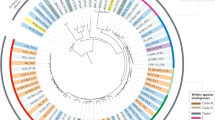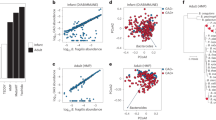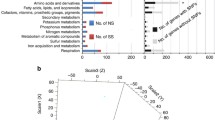Abstract
FimH, the mannose-specific, type 1 fimbrial adhesin of Escherichia coli, acquires amino acid replacements adaptive in extraintestinal niches (the genitourinary tract) but detrimental in the main habitat (the large intestine). This microevolutionary dynamics is reminiscent of an ecological “source-sink” model of continuous species spread from a stable primary habitat (source) into transient secondary niches (sink), with eventual extinction of the sink-evolved populations. Here, we have adapted two ecological analytical tools—diversity indexes D S and α—to compare size and frequency distributions of fimH haplotypes between evolutionarily conserved FimH variants (“source” haplotypes) and FimH variants with adaptive mutations (putative “sink” haplotypes). Both indexes show two- to threefold increased diversity of the sink fimH haplotypes relative to the source haplotypes, a pattern that ran opposite to those seen with nonstructural fimbrial genes (fimC and fimI) and housekeeping loci (adk and fumC) but similar to that seen with another fimbrial adhesin of E. coli, papG-II, also implicated in extraintestinal infections. The increased diversity of the sink pool of adhesin genes is due to the increased richness of the haplotypes (the number of unique haplotypes), rather than their evenness (the extent of similarity in relative abundances). Taken together, this pattern supports a continuous emergence and extinction of the gene alleles adaptive to virulence sink habitats of E. coli, rather than a one-time change in the habitat conditions. Thus, ecological methods of species diversity analysis can be successfully adapted to characterize the emergence of microbial virulence in bacterial pathogens subject to source-sink dynamics.






Similar content being viewed by others
References
Ewens WJ (1972) The sampling theory of selectively neutral alleles. Theor Pop Biol 3:87–112
Feil EJ, Spratt BG (2001) Recombination and the population structures of bacterial pathogens. Annu Rev Microbiol 55:561–590
Fisher RA (1943) The relation between the number of species and the number of individuals in a random sample of an animal population. Part 3. A theoretical distribution for the apparent abundance of different species. J Anim Ecol 12:54–58
Fu YX, Li WH (1993) Statistical tests of neutrality of mutations. Genetics 133:693–709
Hill MO (1973) Diversity and evenness: a unifying notation and its consequences. Ecology 54:427–432
Hommais F, Gouriou S, Amorin C, Bui H, Rahimy MC, Picard B, Denamur E (2003) The FimH A27V mutation is pathoadaptive for urovirulence in Escherichia coli B2 phylogenetic group isolates. Infect Immun 71:3619–3622
Klemm P, Christiansen G (1987) Three fim genes required for the regulation of length and mediation of adhesion of Escherichia coli type 1 fimbriae. Mol Gen Genet 208:439–445
Lancaster A, Nelson MP, Single RM, Meyer D, Thomson G (2003) PyPop:a software framework for population genomics:analyzing large-scale multi-locus genotype data. In: Altman RB, et al. (eds) Pacific Symposium on Biocomputing 8. World Scientific, Singapore, pp 514–525
Nei M, Gojobori T (1986) Simple methods for estimating the numbers of synonymous and nonsynonymous nucleotide substitutions. Mol Biol Evol 3:418–426
Orr MR, Smith TB (1998) Ecology and speciation. Trends Ecol Evol 13:502–506
Pielou EC (1969) An introduction to mathematical ecology. Wiley-Interscience, New York, pp 203–233
Pulliam HR (1988) Sources, sinks, and population regulation. Am Nat 132:652–661
Salamon H, Klitz W, Easteal S, Gao X, Erlich HA, Fernandez–Viña M, Trachtenberg EA, McWeeney SK, Nelson MP, Thomson G (1999) Evolution of HLA class II molecules: allelic and amino acid site variability across populations. Genetics 152:393–400
Roberts JA, Marklund BI, Ilver D, Haslam D, Kaack MB, Baskin G, Louis M, Möllby R, Winberg J, Normark S (1994) The Gal(alpha 1-4)Gal-specific tip adhesin of Escherichia coli P-fimbriae is needed for pyelonephritis to occur in the normal urinary tract. Proc Natl Acad Sci USA 91:11889–11893
Simpson EH (1949) Measurement of diversity. Nature 163:688
Slatkin M (1994) An exact test for neutrality based on the Ewens sampling distribution. Genet Res 64:71–74
Slatkin M (1996) A correction to the exact test based on the Ewens sampling distribution. Genet Res 68:259–260
Sokurenko EV, Chesnokova V, Doyle RJ, Hasty DL (1997) Diversity of the Escherichia coli type 1 fimbrial lectin. Differential binding to mannosides and uroepithelial cells. J Biol Chem 272:17880–17886
Sokurenko EV, Courtney HS, Maslow J, Siitonen A, Hasty DL (1995) Quantitative differences in adhesiveness of type 1 fimbriated Escherichia coli due to structural differences in fimH genes. J Bacteriol 177:3680–3686
Sokurenko EV, Chesnokova V, Dykhuzien DE, Ofek I, Wu X-R, Krogfelt KA, Struve C, Schembri MA, Hasty DL (1998) Pathogenic adaptation of Escherichia coli by natural variation of the FimH adhesin. Proc Natl Acad Sci USA 95:8922–8926
Sokurenko EV, Feldgarden M, Trintchina E, Weissman SJ, Avagyan S, Chattopadhyay S, Johnson JR, Dykhuizen DE (2004) Selection footprint in the FimH adhesin shows pathoadaptive niche differentiation in Escherichia coli. Mol Biol Evol 21:1373–1383
Sokurenko EV, Gomulkiewicz R, Dykhuizen DE (2006) Source–sink dynamics of virulence evolution. Nat Rev Microbiol 4:548–555
Tajima F (1989) Statistical method for testing the neutral mutation hypothesis by DNA polymorphisms. Genetics 123:585–595
Watterson GA (1978) The homozygosity test of neutrality. Genetics 88:405–417
Weissman SJ, Chattopadhyay S, Aprikian P, Obata-Yasuoka M, Yarova-Yarovaya Y, Stapleton A, Ba-Thein W, Dykhuizen D, Johnson JR, Sokurenko EV (2006) Clonal analysis reveals high rate of structural mutations in fimbrial adhesins of extraintestinal pathogenic Escherichia coli. Mol Microbiol 59:975–988
Welch RA, Burland V, Plunkett III G, Redford P, Roesch P, Rasko D, Buckles EL, Llou S-R, Boutin A, Hackett J, Stroud D, Mayhew GF, Rose DJ, Zhou S, Schwartz DC, Perna NT, Mobley HLT, Donnenberg MS, Blattner FR (2002) Extensive mosaic structure revealed by the complete genome sequence of uropathogenic Escherichia coli. Proc Natl Acad Sci USA 99:17020–17024
White GC, Bennetts RE (1996) Analysis of frequency count data using the negative binomial distribution. Ecology 77:2549–2557
Yang Z (1997) PAML:a program package for phylogenetic analysis by maximum likelihood. Comput Appl BioSci 13:555–556
Acknowledgments
This study is supported by NIH grants GM60731 and DK053369.
Author information
Authors and Affiliations
Corresponding author
Additional information
[Reviewing Editor: Dr. Margaret Riley]
Rights and permissions
About this article
Cite this article
Chattopadhyay, S., Feldgarden, M., Weissman, S.J. et al. Haplotype Diversity in “Source-Sink” Dynamics of Escherichia coli Urovirulence. J Mol Evol 64, 204–214 (2007). https://doi.org/10.1007/s00239-006-0063-5
Received:
Accepted:
Published:
Issue Date:
DOI: https://doi.org/10.1007/s00239-006-0063-5




